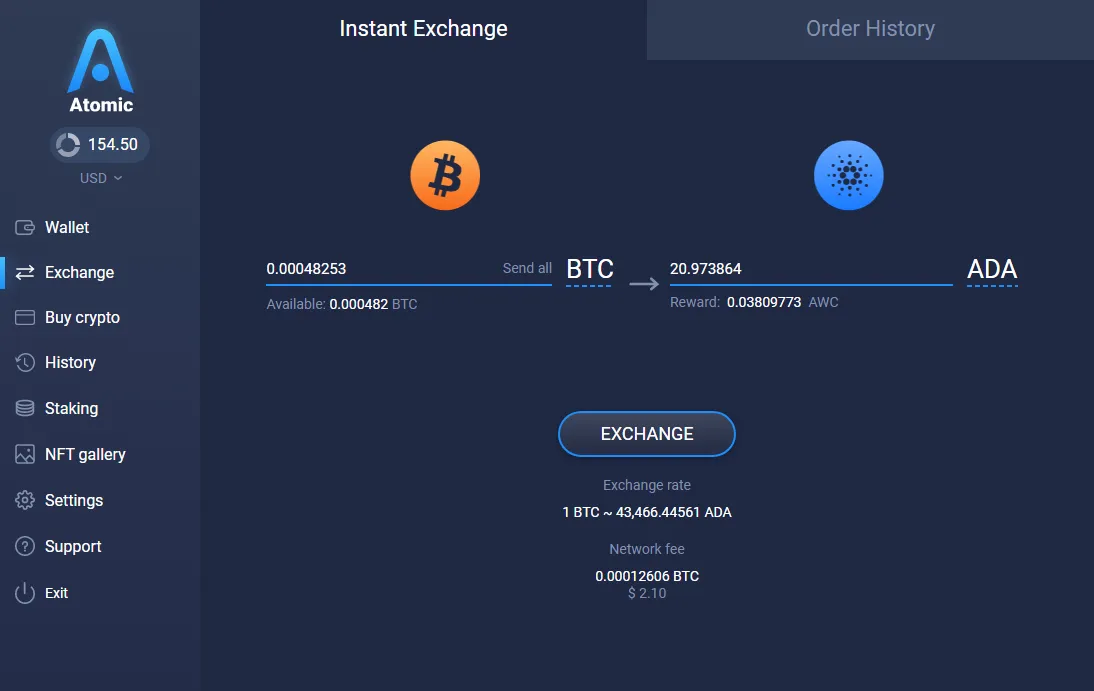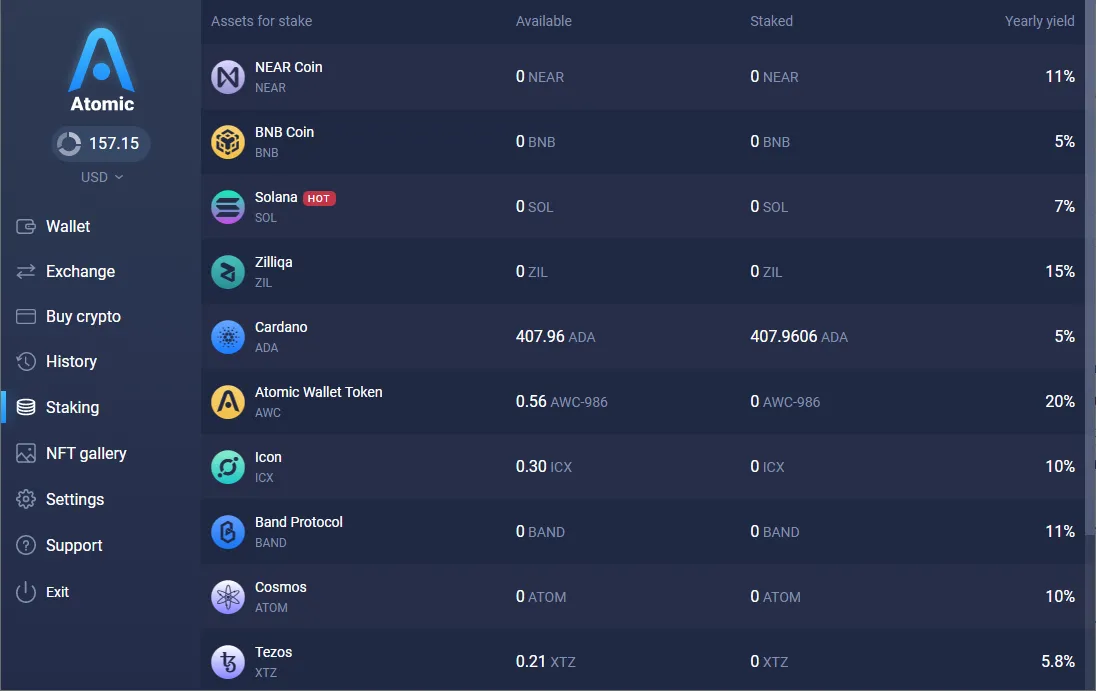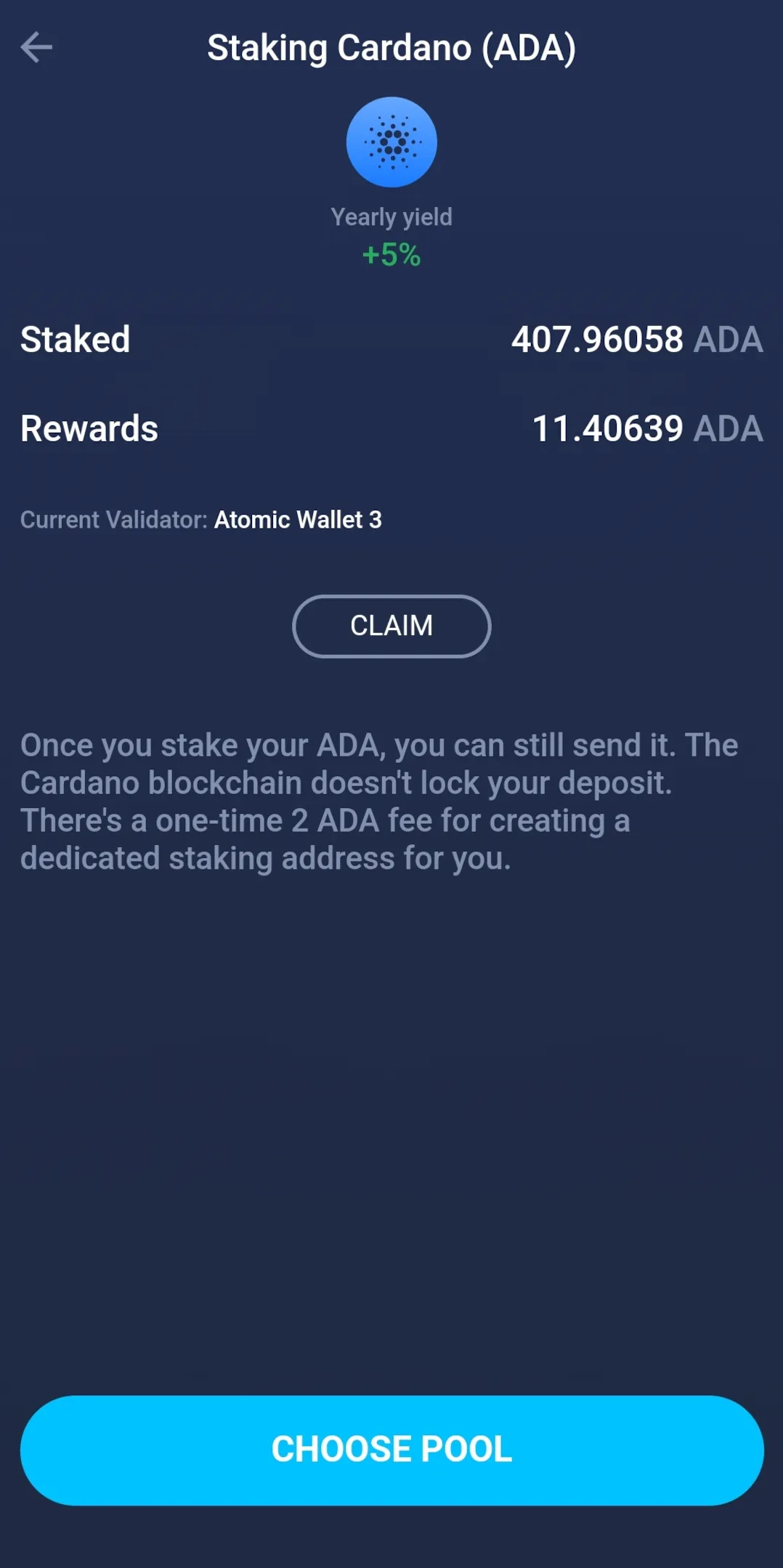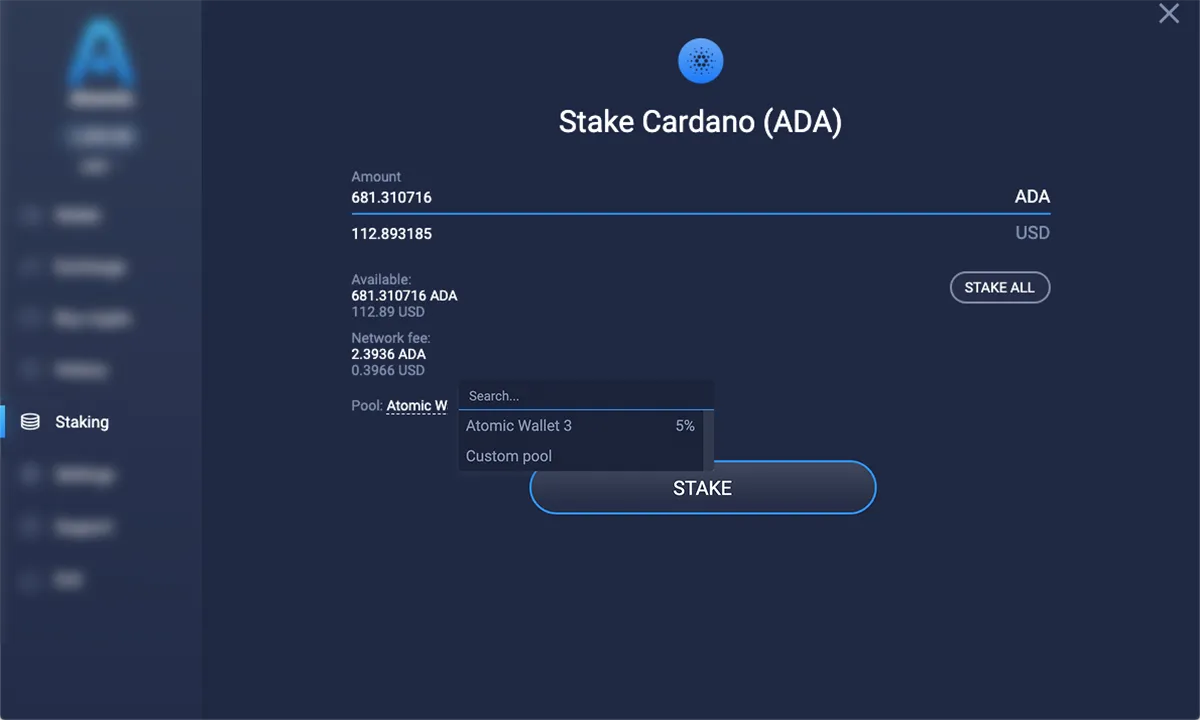Ethereum
ROI ~5%Solana
ROI ~7%Cardano
ROI ~3.06%BNB
ROI ~2.5%Polygon
ROI ~4.2%Tron
ROI ~5%Cosmos
ROI ~16.14%Hedera
ROI ~0.7%Kava
ROI ~6.61%Near
ROI ~7.41%Zilliqa
ROI ~12%Band Protocol
ROI ~12.69%MultiversX
ROI ~7.49%Osmosis
ROI ~5.58%Atomic Wallet Token
ROI ~20%Terra Classic
ROI ~12%Terra LUNA
ROI ~7%Flare
ROI ~4.2%ICON
ROI ~10%Algorand
ROI ~0.63%Tezos
ROI ~5.8%Komodo
ROI ~5.1%VeChain
ROI ~1.63%Injective
ROI ~17%Cronos
ROI ~5.54%Akash Network
ROI ~14%4 steps to get your ADA rewards
Get wallet
Install the app on your system
Deposit crypto
Deposit ADA to your account
Stake crypto
Choose a validator and stake ADA
Claim Rewards
You will start earning rewards in 15-21 days after staking.

What is Cardano (ADA)?
Cardano (ADA) is a proof-of-stake blockchain founded based on scientific, peer-reviewed methods in its development. It brings together technologies to come up with sustainable solutions in the development of decentralized applications, providing unparalleled security. One of Cardano’s goals is to become a force of positive change by creating accountability in existing systems.
Cardano was created in 2017 by Jeremy Wood and Charles Hoskinson, one of the co-founders of Ethereum (ETH).
Ouroboros
Cardano uses its peer-reviewed proof-of-stake protocol, called Ouroboros. It’s designed in a way that enables Cardano scalability in a sustainable yet secure manner. One of the core concepts in the makeup of Ouroboros is the mathematical concept of infinity. This means Cardano can be used to develop an unlimited number of applications without affecting the efficiency of the whole network.
What is Cardano staking?
In a blockchain network that is built on a proof-of-stake consensus mechanism, validators that are adding new blocks to the blockchain and processing transactions are chosen at random, as opposed to a competitive approach of the proof-of-work networks. With ADA, the process is random, but the more stake a stake pool has (i.e. the amount of cryptocurrency staked with a particular validator), the more likely they are to be the one to add new blocks to the blockchain. Pools are rewarded for adding a new block and this reward is then shared among ADA holders who staked their assets with them. In short, the Cardano network represents a great opportunity for ADA holders to participate in processing transactions and get some passive income going.
The aforementioned features are pretty common among the proof-of-stake networks, not just ADA. Let's take a closer look at what makes staking ADA unique, most notably, the pools.
ADA stake pools
With ADA, network participants have the option of staking their funds via so-called 'stake pools' (not to be confused with mining pools) It is sort of a joint purse, which lots of ADA holders can deposit their money into. People who join these pools have their tokens 'pooled' together. Users have complete freedom to choose which pool they’d like to join and can review each one based on their previous performance, uptime, and size of the pool.
Stake pool operators
Stake pool operators are, as the name suggests, the people or groups of people that have enough expertise and equipment to make a stake pool run, i.e. to work properly and without failure.
Can I create my own stake pool?
If your interest is to do more than just earn rewards, then certainly! The point is, the Cardano community places no restrictions on who exactly can become an operator and run a stake pool. If you have the knowledge and tech to pull it off, you are more than welcome!
Staking ADA With Atomic Wallet
If you wish to get into Cardano staking instead of simply holding ADA on your address, Atomic Cardano Wallet is a great place to start. It is a secure, decentralized, and custody-free staking option, available both on desktop and mobile devices.
Things you need to know
You need to cover a network fee every time you claim your ADA rewards. The fees are charged by the Cardano blockchain directly, and we don't have any additional ones. If you're interested in learning more about how network fees work, see Does Atomic Wallet charge any additional transaction fees?.
Your ADA is not locked when you stake it. It will stay in your available balance. Unlike most other blockchains, Cardano doesn't freeze your deposit for the staking period. You're still free to send or swap your at any time.
You’re staking all of your ADA. You can’t decide how much ADA you want to delegate—you’re staking all the money you currently have on your ADA balance. The minimum staking amount is 4 ADA. If you deposit more ADA to your address, they’ll get added to the staking pool automatically. Please note that the staking cycle will start anew in this case.
You’ll have to pay a one-time 2 ADA deposit fee. It’s charged by the Cardano blockchain as well. You’ll only have to pay it once, right when you stake your ADA.
You’ll receive your first staking rewards in ca. 20 days. After that, you should receive rewards every epoch (about 5 days).
Get some ADA in your wallet
Once you’ve installed Atomic Cardano Wallet on your device and set it up, you need to get some ADA tokens.
Buying ADA
The easiest way to get some ADA into your Atomic Cardano Wallet is to purchase it right here, in the app. Buying ADA will have you fill out some forms and go through verification. After that, you can pay with a debit or a credit card. A thorough, step-by-step guide on buying any crypto in Atomic Wallet is available here.

Swap other tokens for ADA
If you want to stake Cardano right now, but only have Eos, for example, you ca swap it for ADA using our built-in exchange. You can freely swap tokens without having to verify your identity or follow time-consuming ‘Know Your Customer (KYC) protocols. The swap also has real-time prices for assets and swap s, so you can the best possible deal. A step-by-step guide on swapping assets in Atomic Wallet is available here.

Deposit ADA into Atomic Wallet
If you have some ADA on one of the crypto exchanges that doesn't support Cardano staking, you can simply send it to your ADA address in Atomic and start staking Cardano right away. Depositing a crypto asset into Atomic is easy. Just find the coin you wish to deposit in the wallet's interface, copy the address, and send tokens to this address. Here's a more detailed breakdown of the procedure.
Time to stake ADA tokens
Now that you've got some Cardano, you can start staking. Staking Cardano in Atomic is pretty straightforward.
Let's get into the staking tab. Click 'Staking' on the left sidebar in the desktop version of the app. If you're on mobile, the button is located in the bottom panel. The staking tab is a list of all the assets available for staking in Atomic, along with their APYs. Here's an example:

Select Cardano. You'll see the ADA staking interface.

Staked is your staked balance. I.e., the amount of ADA you're staking at the moment.
Rewards are the number of rewards your staking pool has generated up to now.
Atomic doesn't have the 'Delegate' button like Yoroi wallet has, for example. Press the 'Choose pool' button at the bottom of the screen. This screen allows you to choose the stake pool you want to stake Cardano with. By default, our own pool is selected. Yes, we do have our own Cardano staking pool! But there are lots of other staking pools available for ADA, so you can choose the 'Custom pool' option. Different pools promise different APYs, so make sure to research the ADA market, before committing to a pool. APY is a great way to estimate how much passive income you're going to get over a certain period.
You'll also see how much ADA you'll have to pay in-network fees. Remember that Atomic does not charge any additional transaction fees from its users.

Choose the pool and press 'Stake'. Confirm it by entering your password. You did it! Your ADA tokens are now staked. You can relax and wait for your reward to arrive.
When will I get my rewards?
You'll receive your first staking rewards in about 20 days after staking your ADA. After that, you'll earn rewards for every epoch, which is about 5 days. You can always check the status of the current epoch and what reward you're going to get, on an ADA block explorer, Cardanoscan, for example.
Keep in mind, however, that if you decide to stake more coins, the cycle will reset and you'll have to wait for another 20 days to be rewarded for this additional investment.
Once you see your interest in the form of rewards show up in the wallet, simply press the 'Claim' button. The minimum amount to claim is 0.5 ADA. Friendly advice: don't claim your rewards too often, it's always best to claim less often and pay less ADA in fees. The good thing is that your rewards won't expire, so you're free to claim your ADA whenever you want.
How do I unstake my ADA?
What's really convenient about Cardano, it's that there's no need to unstake your deposit, as it's not locked. You can always move your coins around, staked or not. If need your ADA tokens to stop generating rewards, the only way would either be to create a new wallet and transfer your coins there or swapswap your some other tokens.
I still have questions!
If you need an even more detailed guide on Cardano staking, check out the article in our Knowledge Base!
If you have any issues with staking or claiming your funds, you contact Atomic Wallet’s 24/7 customer support team (by reaching out directly through this online contact form).
Get on board today
Staking Cardano in Atomic Cardano Wallet is a straightforward process, that lets you put your ADA tokens to work while maintaining full control of your Cardano and insuring the security and stability of the Cardano network. Staking lets you earn rewards and contribute to the safety of the blockchain network. Stake your ADA in Atomic and start earning rewards right away!










